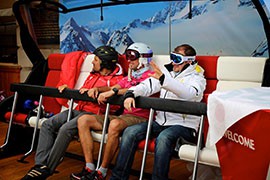Cronkite News has moved to a new home at cronkitenews.azpbs.org. Use this site to search archives from 2011 to May 2015. You can search the new site for current stories.
National houses provide a home away from home
LONDON – In an Olympic atmosphere, national pride sometimes is overshadowed by the collision of world cultures. National houses aim to create a home away from home for fans and athletes as well as bring the best their countries have to offer to the world stage.
“Every day is like a party,” said Christina Thurnbichler, an employee of the Austria house in London. “We have good food, good beer. It’s a good time.”
On any given day, the Austria house can be found with a deck full of visitors enjoying music, drinks and each other.
“We were going to the Tower Bridge when we heard music and decided to stop and check it out,” said Ana Shapiro, a Canadian who stopped at the Austria house for a drink. “The setting is really amazing. I like all of the materials used, and the uniforms are great.”
Tanya Parisella echoed that. “It is really sophisticated, but still fun,” she said.
The area outside the house has different themed days to show off different parts of Austria. A large deck area built to resemble that of a mountain lodge is open to the public complete with skis and snowboards, a lift chair and even a yodeling contest in a phone booth.
“It is very nice to take photos on the ski lift,” Thurnbichler said. “It has been very popular.”
Not all of the houses expected to be popular received such rave reviews. The Brazil house, located right off the Thames River, is much quieter and apparently less a national house.
Upon arrival, visitors enter a room with a countdown clock to the 2016 Summer Olympics in Rio de Janeiro and a simple sign displaying the logo of that country’s games.
“It’s the new face of Brazil we are trying to show the world,” said Casa Brazil employee Jamara Ibanez Dasilva.
The main attraction, a large art exhibit, features modern art depicting all aspects of Brazilian life, geography and culture. Although audio guides are available, most visitors did not use them.
“I think it’s quite interesting to bring modern art into Olympics landscape,” said Cedric Girard, a French visitor to Casa Brazil. “I know Rio quite well, so it’s not surprising to me. It’s daring and shows that Brazil wants to have a point of view on sports and society.”
Not all visitors shared Girard’s open-minded point of view. The exhibit confused most visitors, many rushing past the more baffling displays.
The souvenir shop at Casa Brazil attracted the most attention; packed with pins, shirts and everything Olympics, visitors snatched up memorabilia four years before the actual games.
“I would have expected it to be more energetic from an artistic point of view,” Girard said. Along with most visitors there, Girard had planned to visit Casa Brazil.
The Belgium house, another house expected to be popular, primarily features the country’s cycling. “We have this interactive set up which offers visitors to experience all different regions of Belgium,” said Rosa Barker, an employee of the Belgium house.
Tom Winterton jumped on a stationary bike that provided a virtual ride through southern Belgium. “It seems like they put a lot of effort into the house,” said Winterton, who, like many visitors at the Belgium house, is a big cycling fan.
For a small entrance fee, visitors can enjoy traditional drinks and beers inside the Belgium house. They can also watch interviews with Belgian athletes who stop by.
“Most of the people have come here because they know that the Belgium house is here,” Barker said. “But they seem happy with the culture they are experiencing here. It is truly a piece of Belgium.’’
The turnout at national houses across London has had mixed reactions. Houses like those of Austria and Switzerland see a lot of traffic because of outside decoration or advantageous locations. But the Russian Triol house, expected to be popular because the 2014 Winter Olympics will be in that country, has dropped its admission fees to attract more visitors.
“I think all of the national houses needed to be publicized more,” Winterton said. “You can usually only find them if you are looking for them. Very few houses are outwardly inviting. Regardless, they are all really worth seeing.”









